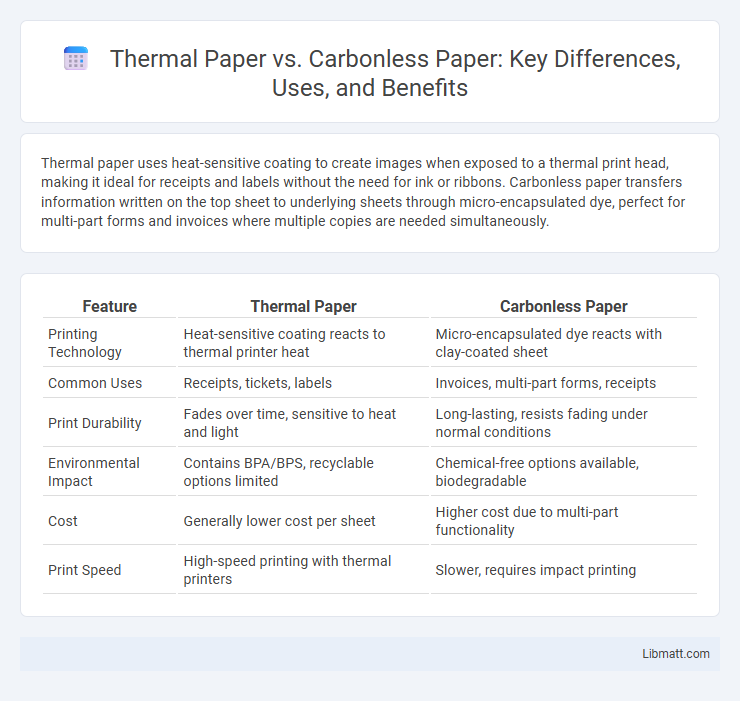Thermal paper uses heat-sensitive coating to create images when exposed to a thermal print head, making it ideal for receipts and labels without the need for ink or ribbons. Carbonless paper transfers information written on the top sheet to underlying sheets through micro-encapsulated dye, perfect for multi-part forms and invoices where multiple copies are needed simultaneously.
Table of Comparison
| Feature | Thermal Paper | Carbonless Paper |
|---|---|---|
| Printing Technology | Heat-sensitive coating reacts to thermal printer heat | Micro-encapsulated dye reacts with clay-coated sheet |
| Common Uses | Receipts, tickets, labels | Invoices, multi-part forms, receipts |
| Print Durability | Fades over time, sensitive to heat and light | Long-lasting, resists fading under normal conditions |
| Environmental Impact | Contains BPA/BPS, recyclable options limited | Chemical-free options available, biodegradable |
| Cost | Generally lower cost per sheet | Higher cost due to multi-part functionality |
| Print Speed | High-speed printing with thermal printers | Slower, requires impact printing |
Introduction to Thermal Paper and Carbonless Paper
Thermal paper is a specialized paper coated with a chemical that changes color when exposed to heat, commonly used in receipts and labels for instant printing without ink. Carbonless paper contains micro-encapsulated dye or ink that transfers to the sheet beneath when pressure is applied, making it ideal for multi-part forms and invoices. Both types enhance efficiency in documentation but differ significantly in printing technology and applications.
How Thermal Paper Works
Thermal paper works by using a special heat-sensitive coating that changes color when exposed to the thermal print head's heat, eliminating the need for ink or ribbons. The heat activates the chemicals in the coating, producing clear, sharp images or text instantly. Your choice of thermal paper ensures fast, reliable printing for receipts, labels, and tickets with minimal maintenance.
How Carbonless Paper Works
Carbonless paper works through micro-encapsulated dye or ink on the back of the top sheet that ruptures under pressure, transferring the image to the sheets below without the need for carbon paper. The chemical reaction between the dye capsules and a reactive clay or resin coating on the subsequent sheets creates a permanent copy. This technology allows you to produce multiple copies simultaneously, making it ideal for invoices, receipts, and forms requiring duplicates.
Key Differences Between Thermal and Carbonless Paper
Thermal paper relies on heat-sensitive coating that changes color when exposed to a thermal print head, enabling fast, clean printing without ink or toner, while carbonless paper uses micro-encapsulated dye and clay layers to transfer writing pressure from the top sheet to sheets beneath, creating duplicates without carbon sheets. Thermal paper is ideal for receipts and labels requiring high-speed printing with minimal maintenance, whereas carbonless paper suits multi-part forms and invoices where simultaneous copies are necessary without electronic devices. The durability of thermal paper is limited by heat and light exposure, contrasting with carbonless paper's sensitivity to humidity and pressure, affecting the longevity and clarity of the imprints.
Print Speed and Image Quality Comparison
Thermal paper offers faster print speeds due to its direct heat-sensitive coating, enabling rapid image formation without the need for ink or ribbons, which is ideal for high-volume receipt printing. Carbonless paper produces high-quality, sharp images by transferring micro-encapsulated dye to adjacent sheets, providing clear multi-part copies but at slower print speeds compared to thermal technology. Your choice depends on whether speed or image clarity in multi-copy documentation is your priority.
Durability and Longevity of Printed Images
Thermal paper features a heat-sensitive coating that provides sharp, clear images but tends to fade over time when exposed to heat, light, or oils, limiting its durability and longevity. Carbonless paper uses micro-encapsulated dye that produces images through pressure, delivering more stable prints that resist fading and maintain legibility for several years. For applications requiring extended image retention, carbonless paper offers superior durability compared to thermal paper, which is better suited for short-term uses like receipts.
Environmental Impact and Recyclability
Thermal paper contains a chemical coating that often includes BPA or BPS, which can pose environmental and health risks, and its recyclability is limited due to this coating. Carbonless paper uses micro-encapsulated dyes and developers without harmful chemicals, making it more environmentally friendly and easier to recycle in standard paper streams. Choosing carbonless paper reduces chemical contaminants and supports sustainable waste management practices compared to thermal paper.
Common Applications and Industries
Thermal paper is widely used in retail and hospitality for receipts, tickets, and labels due to its fast, heat-based printing process. Carbonless paper is preferred in healthcare, insurance, and logistics for multi-part forms and invoices where duplicate copies are essential without using carbon sheets. Both paper types serve distinct industries based on the need for real-time printing versus reliable duplicate documentation.
Cost Considerations
Thermal paper generally offers lower upfront costs due to its simplicity and reduced need for ink or ribbon, making it cost-effective for high-volume printing tasks like receipts and tickets. Carbonless paper, while slightly more expensive per sheet, eliminates the need for separate carbon sheets and is ideal for multi-part forms requiring instant duplicates without additional supplies. Your choice between thermal and carbonless paper should weigh initial material costs against long-term operational expenses and the specific requirements of your printing needs.
Choosing the Right Paper for Your Business
Thermal paper offers quick, high-quality printouts ideal for retail receipts and shipping labels, requiring no ink or ribbons, which reduces maintenance costs. Carbonless paper is perfect for multi-part forms like invoices and delivery receipts, as it transfers information across sheets without messy carbon sheets. Selecting between thermal and carbonless paper depends on your business needs for durability, print quality, and ease of use in transaction documentation.
Thermal paper vs carbonless paper Infographic

 libmatt.com
libmatt.com